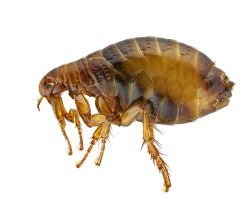Description:
Fleas are wingless, with mouthparts adapted for piercing skin and sucking blood. Fleas are external parasites, living by hematophagy off the blood of mammals and birds.
Appearance:
Fleas are wingless insects, 1.5 to 3.3 mm long, that are agile, usually dark colored, with tube-like mouth parts adapted to feeding on the blood of their hosts. They interestingly do not possess a mandible. Their legs are long, the hind pair well adapted for jumping. Atypical of other insects, fleas do not possess compound eyes but instead have simple eyes with a single biconvex lens. The flea body is covered with hard plates called sclerites. These sclerites are covered with many hairs and short spines directed backward, which also assist its movements on the host. The tough body is able to withstand great pressure, likely an adaptation to survive attempts to eliminate them by mashing or scratching.
Lifecycle:
Adult fleas must feed on blood before they can become capable of reproduction. Once the flea reaches adulthood, its primary goal is to find blood and then to reproduce. Its total life span can be as long as one and one-half years in ideal conditions. Female fleas can lay 5000 or more eggs over their life, allowing for phenomenal growth rates. Average 30–90 days. A flea might live a year and a half under ideal conditions. These include the right temperature, food supply, and humidity.
Habits:
Fleas feed on a wide variety of warm-blooded vertebrates including dogs, cats, humans, chickens, rabbits, squirrels, rats, ferrets, and mice. Fleas are a nuisance to their hosts, causing an itching sensation which in turn may result in the host attempting to remove the pest by biting, pecking, scratching, etc. in the vicinity of the parasite. Fleas are not simply a source of annoyance, however. Flea bites generally cause the formation of a slightly raised, swollen itching spot with a single puncture point at the center. The bites often appear in clusters or lines of two bites, and can remain itchy and inflamed for up to several weeks afterwards. Fleas can also lead to hair loss as a result of frequent scratching and biting by the animal, and can cause anemia in extreme cases.
